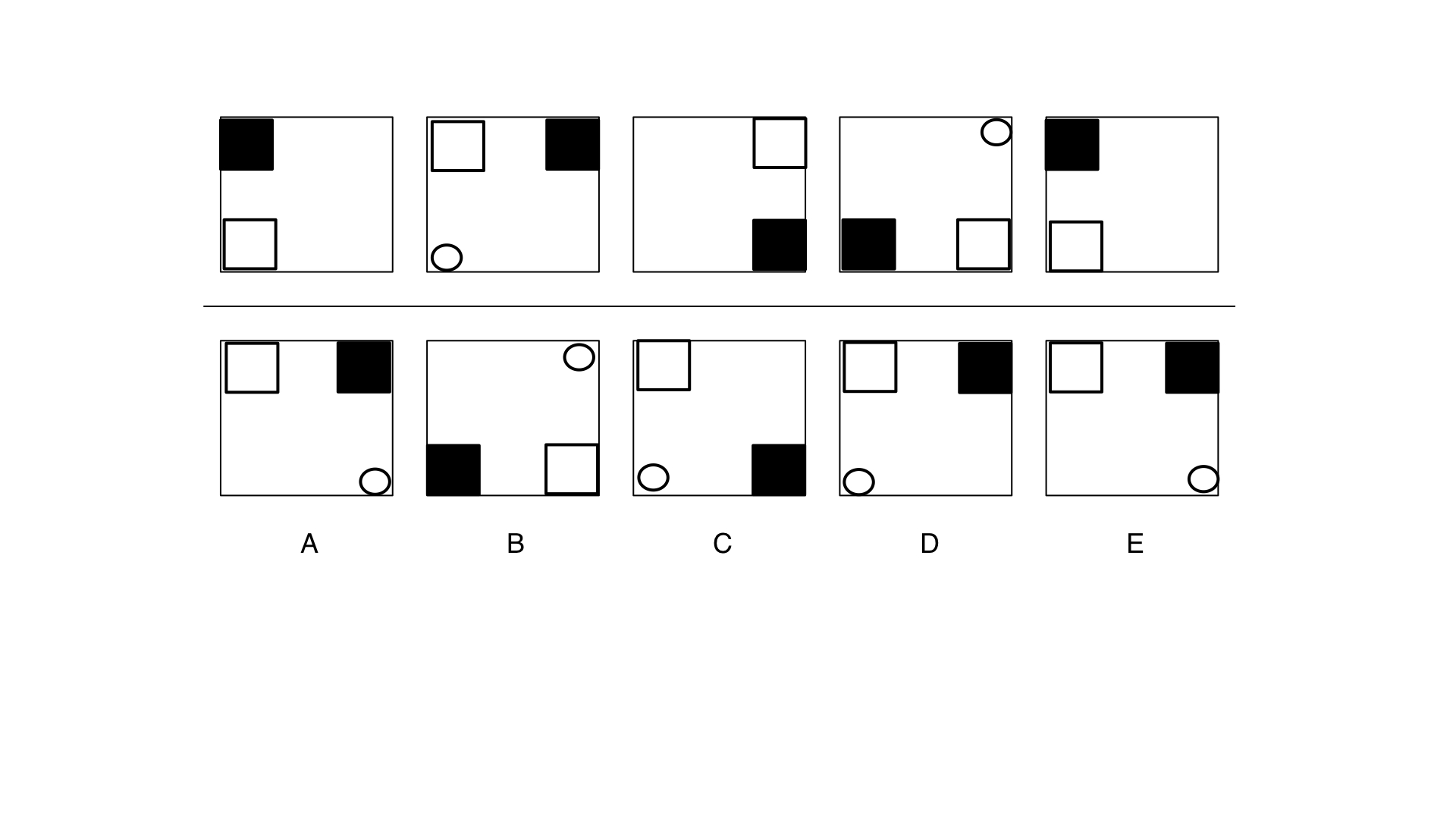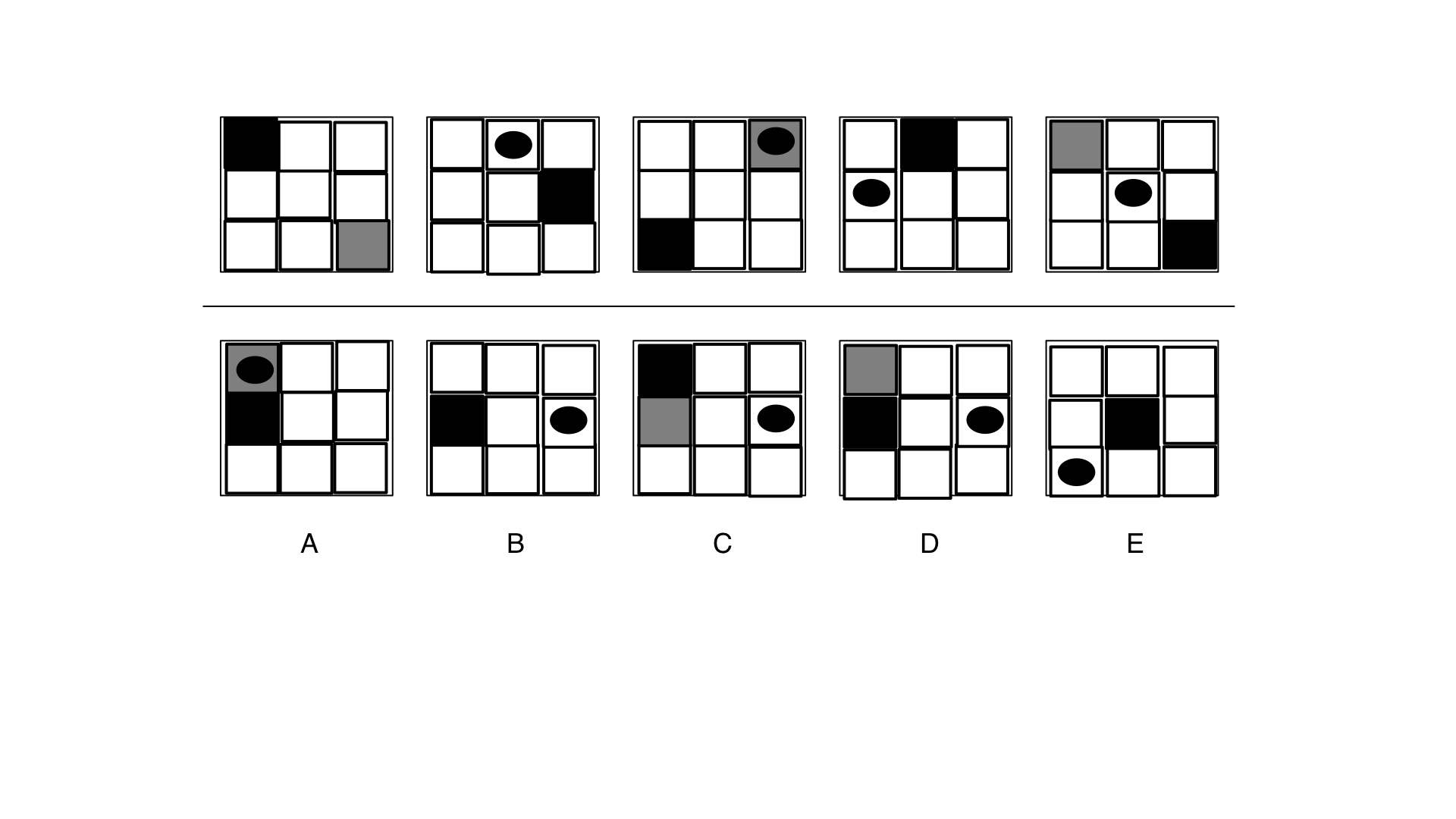FREE Hogan Cognitive Ability Questions and Answers
Which box follows the other in the order?

Rule 1: The shaded square circles the square in a clockwise direction.
Rule 2: Each step, the unshaded square inside the thin square rotates counterclockwise.
Rule 3: In Figure 1, the circle (which begins behind the shaded square) advances counterclockwise at each turn and vanishes behind the square when the two points coincide.
Which box follows the other in the order?

Rule 1: The scale is straight, then it is entirely tipped to the left, then to the right, and then it is fully tipped back to straight. The sequence then repeats.
Rule 2: The triangle and circle are lighter than the square. The weight of the triangle and circle is equal.
Rule 3: The support triangle switches back and forth between being shaded and being unshaded, or shaded, shaded, unshaded.
Which box follows the other in the order?

Rule 1: The shapes rotate one corner clockwise every time.
Rule 2: Triangles and circles are alternately used as shapes.
Rule 3: In the order shaded, shaded, unshaded, unshaded, and repeat, the shading alternates between shaded and unshaded.
Which box follows the other in the order?

Rule 1: The triangle's size alternates between big, medium, and small, and then it is repeated.
Rule 2: The top left and top right corners alternately serve as the location of the circle.
Rule 3: The circle's shading and opacity change in turn.
Which box follows the other in the order?

Rule 1: Every time, the square shifts one space to the left.
Rule 2: Every time, the circle shifts one space to the right.
Rule 3: The shades and outlines of both shapes alternate.
Which box follows the other in the order?

Rule 1: The grey square goes 1 square counterclockwise around the perimeter of the image with each step, and when the two squares line up, it disappears behind the black square.
Rule 2: The little circle, which begins behind the black square, moves one square from left to right before dropping the row and starting over to the left of the figure.
Rule 3: The black square will rotate the figure's edge 3 squares clockwise with each step.
Which box follows the other in the order?

Rule 1: The shapes' sizes alternate between medium, large, and small, then they repeat.
Rule 2: The arrow changes from being present to being absent.
Rule 3: Shaded and unshaded areas alternate in the shading.
Advertisement
What does the Hogan Cognitive Ability test assess?
The Hogan Cognitive Ability test primarily focuses on evaluating verbal reasoning skills, which involve understanding, analyzing, and drawing conclusions from written information.
Which cognitive skill involves the ability to recognize patterns and relationships between objects?
Spatial visualization refers to the capacity to mentally manipulate and understand spatial relationships, which is crucial for tasks involving visualization of objects from different angles.
Which type of reasoning is the Hogan Cognitive Ability test least likely to assess?
The Hogan Cognitive Ability test focuses on cognitive abilities such as inductive and deductive reasoning, critical thinking, and problem-solving, rather than emotional
Inductive reasoning involves:
Inductive reasoning involves making generalizations or predictions based on specific instances or observations.
What is deductive reasoning?
Deductive reasoning involves using general principles or premises to draw specific conclusions.
Which cognitive ability involves evaluating arguments and identifying flaws in reasoning?
Critical thinking involves assessing and analyzing arguments to identify logical flaws and inconsistencies.
The Hogan Cognitive Ability test is designed to predict an individual's potential performance in:
The test is designed to measure cognitive abilities that are relevant to tasks requiring thinking, problem-solving, and decision-making.
Advertisement
Which of the following is an example of abstract reasoning?
Abstract reasoning involves understanding and manipulating concepts and patterns that may not have a direct real-world counterpart.
Numerical reasoning assesses an individual's ability to:
Numerical reasoning involves working with numbers and mathematical concepts to solve problems.